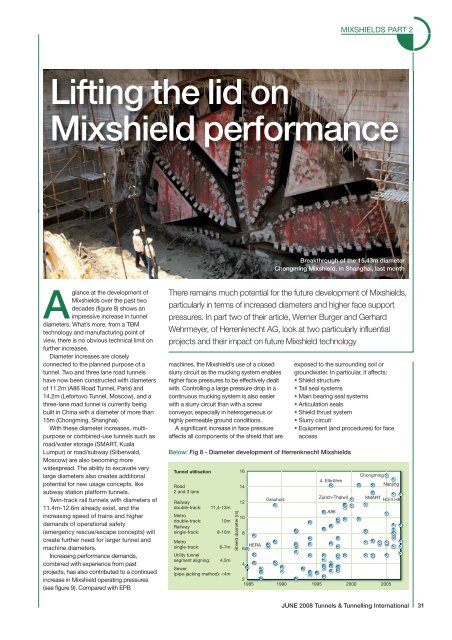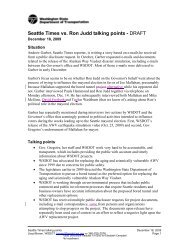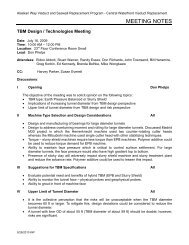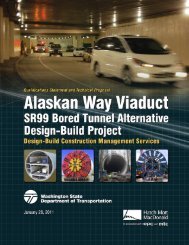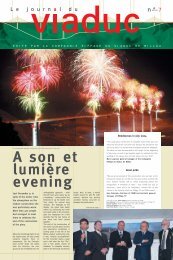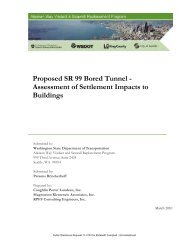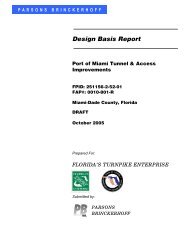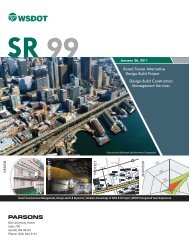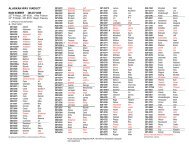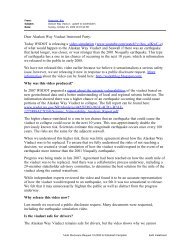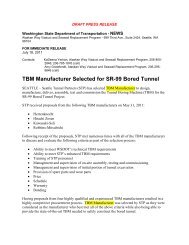herrenknecht ag softground tbms > 40 ft - SCATnow
herrenknecht ag softground tbms > 40 ft - SCATnow
herrenknecht ag softground tbms > 40 ft - SCATnow
Create successful ePaper yourself
Turn your PDF publications into a flip-book with our unique Google optimized e-Paper software.
MIXSHIELDS PART 2<br />
Li<strong>ft</strong>ing the lid on<br />
Mixshield performance<br />
Breakthrough of the 15.43m diameter<br />
Chongming Mixshield, in Shanghai, last month<br />
Aglance at the development of<br />
Mixshields over the past two<br />
decades (figure 8) shows an<br />
impressive increase in tunnel<br />
diameters. What’s more, from a TBM<br />
technology and manufacturing point of<br />
view, there is no obvious technical limit on<br />
further increases.<br />
Diameter increases are closely<br />
connected to the planned purpose of a<br />
tunnel. Two and three lane road tunnels<br />
have now been constructed with diameters<br />
of 11.2m (A86 Road Tunnel, Paris) and<br />
14.2m (Lefortovo Tunnel, Moscow), and a<br />
three-lane road tunnel is currently being<br />
built in China with a diameter of more than<br />
15m (Chongming, Shanghai).<br />
With these diameter increases, multipurpose<br />
or combined-use tunnels such as<br />
road/water stor<strong>ag</strong>e (SMART, Kuala<br />
Lumpur) or road/subway (Silberwald,<br />
Moscow) are also becoming more<br />
widespread. The ability to excavate very<br />
large diameters also creates additional<br />
potential for new us<strong>ag</strong>e concepts, like<br />
subway station platform tunnels.<br />
Twin-track rail tunnels with diameters of<br />
11.4m-12.6m already exist, and the<br />
increasing speed of trains and higher<br />
demands of operational safety<br />
(emergency rescue/escape concepts) will<br />
create further need for larger tunnel and<br />
machine diameters.<br />
Increasing performance demands,<br />
combined with experience from past<br />
projects, has also contributed to a continued<br />
increase in Mixshield operating pressures<br />
(see figure 9). Compared with EPB<br />
There remains much potential for the future development of Mixshields,<br />
particularly in terms of increased diameters and higher face support<br />
pressures. In part two of their article, Werner Burger and Gerhard<br />
Wehrmeyer, of Herrenknecht AG, look at two particularly influential<br />
projects and their impact on future Mixshield technology<br />
machines, the Mixshield’s use of a closed<br />
slurry circuit as the mucking system enables<br />
higher face pressures to be effectively dealt<br />
with. Controlling a large pressure drop in a<br />
continuous mucking system is also easier<br />
with a slurry circuit than with a screw<br />
conveyor, especially in heterogeneous or<br />
highly permeable ground conditions.<br />
A significant increase in face pressure<br />
affects all components of the shield that are<br />
exposed to the surrounding soil or<br />
groundwater. In particular, it affects:<br />
• Shield structure<br />
• Tail seal systems<br />
• Main bearing seal systems<br />
• Articulation seals<br />
• Shield thrust system<br />
• Slurry circuit<br />
• Equipment (and procedures) for face<br />
access<br />
Below: Fig 8 - Diameter development of Herrenknecht Mixshields<br />
Tunnel utilisation<br />
Road<br />
2 and 3 lane<br />
Railway<br />
double-track: 11,4-13m<br />
Metro<br />
double-track: 10m<br />
Railway<br />
single-track: 8-10m<br />
Metro<br />
single-track: 6-7m<br />
Utility tunnel<br />
segment aligning: 4,5m<br />
Sewer<br />
(pipe-jacking method):


